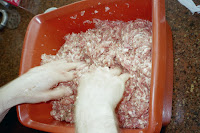It's chilly and rainy again. (I told you these Chicago winters were everlasting.) I'm itching to get my veggie seedlings in the ground—if it ever gets warm enough! I love having fresh produce in the yard. It's satisfying, it's cheap, and it makes healthful eating easier. I like to start my plants from seed when possible, so to get a jump on a short growing season, I start most of the seeds indoors in mid to late March. I'm still learning how to time things right.
This year, I'm embarking on a bigger gardening adventure than usual. It will be interesting to see how we get all this food to grow in our yard; you'll see why a in a little bit. Here's what we have going for Growing Season 2009:
Started from Seed IndoorsCucumbers (small seedlings)
Pumpkins (lots of large
gangly seedlings)
Cherry Tomatoes (teensy seedlings)
Yellow Pear Tomatoes (barely sprouted)
Bell Peppers (thought I saw a sprout... maybe not)
Chives (nothing yet; didn't sprout well last year either)
Cilantro (barely sprouted)
Sweet Basil (barely sprouted)
Flat-Leaf Parsley (barely sprouted)
Jalapeños (nothing yet; seeds may be too old)
Marigolds (nothing yet; seeds may be too old)
Green Chilies from New Mexico (nothing yet, etc.)
Green Beans (nothing yet, etc.)
Sowed Directly OutdoorsSnow Peas (in a container; tall seedlings)
Butternut Squash (in starter cups; nothing yet)
Buttercrunch Lettuce (in a container)*
Romaine Lettuce (in a container)*
Chinese Cabbage (in a container)*
Spinach (in a container)*
*Of these four lettuces, I think three types have sprouted, maybe all four. But I can't remember which seeds I put in which section of the rectangular wooden box, and they're all too small to identify right now.
Already Growing OutdoorsShallots (planted the heads last fall; "green onions" tall already)
Raspberries (planted the bush last fall; new leaves are out)
Grapes (planted the vine last fall; new leaf buds visible)
Strawberries (also harvested last summer; a few new flowers out)
We are going to cram all of these tasty things into our tiny, north-facing backyard that is approximately 25' x 10'. Or we hope to, anyway. (There may also be the option of a plot in a neighborhood garden, but that's another story.) A few things are going into containers on or near the front porch, which faces north and is sunny all the time. The strawberries and grapevine are pretty unobtrusive in the ground right against the porch, and Len found a pair of wooden barrels that nicely flank our little sidewalk—I'll put the tomatoes in those. And I'm experimenting with hanging baskets on the front porch for the
snow peas. Since they like to climb, I will try to train them to drape from one basket to the next. It might look pretty.
But there's hardly room for everything in front (the front yard itself is pretty much a row of bushes and a strip of grass that I'm sure our
homeowners association wants to look pristine). In back, only a strip of ground closest to the alley gets sun almost all day in the summer; that is where we have dug out a rectangle in the ground and also placed the rectangular wooden box I mentioned earlier. The rest of the yard only gets full sun for a few hours at midday, and most edible things don't thrive in that much shade. So, we're planning to squeeze things in here and there. For example, the raspberries and shallots are in the sunniest part of the shady part of the yard (does that make sense?) and doing OK so far.
I'm trying to think three dimensionally to make the best use of all the space around us, not just the space on the ground. We'll see how it goes.
At any rate, I'm already tired of nursing these seedlings and can't wait to put them outside for good. At this point, they've experienced some of the nicer days outside on the porch but have to come back inside for the damp, chilly nights.
Wish me luck, and check back later for the next installment of Adventures in Edible Gardening.














































